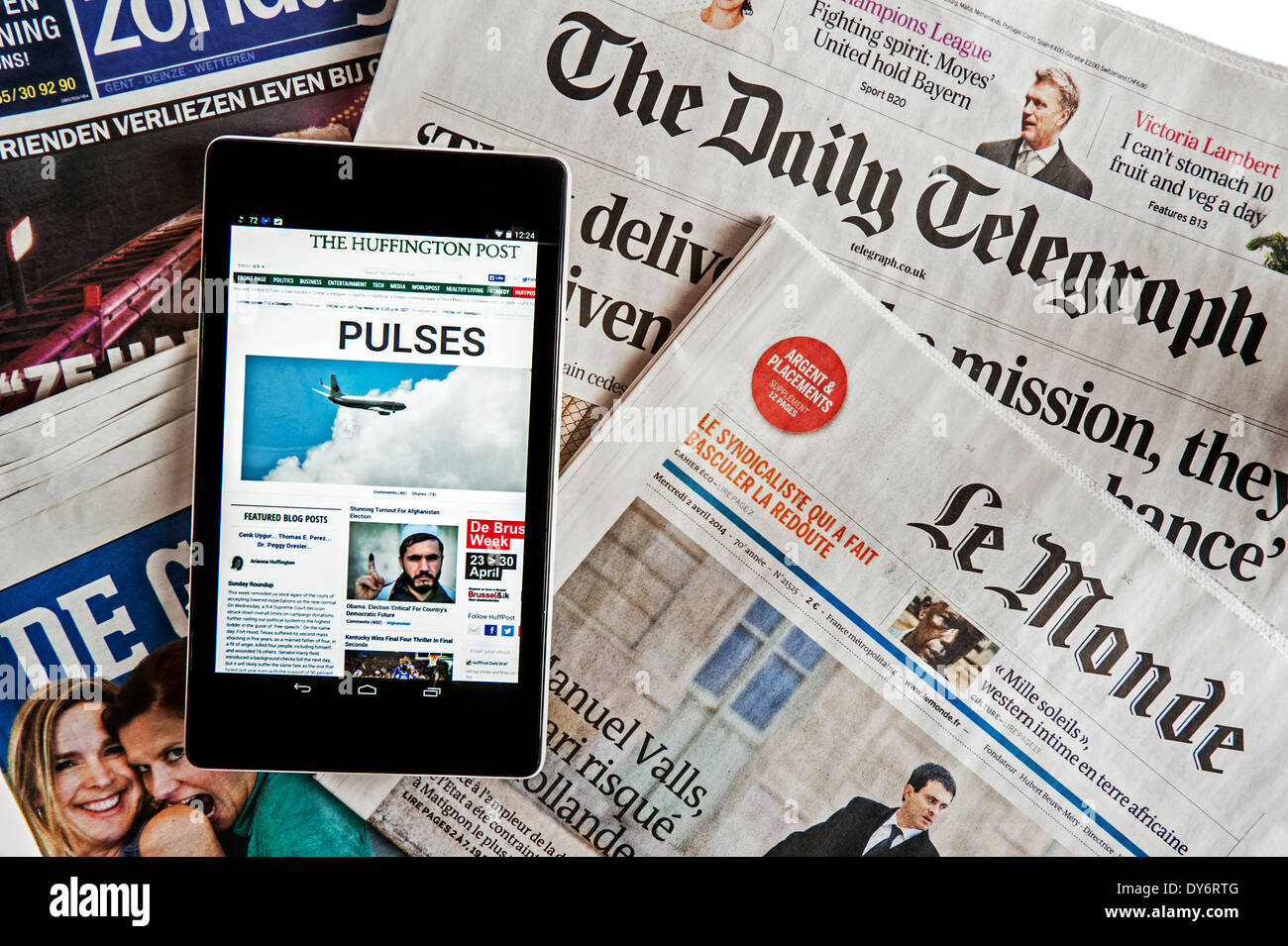Inside Look at How stnews.live Publishes News
The Influence of Social Media en route We Take In News Online
Social network has basically changed news usage. It offers prompt accessibility to details, typically eclipsing standard media outlets. This quick circulation comes with challenges. Individuals encounter the danger of experiencing misinformation and ending up being trapped in resemble chambers. The algorithms driving customized content can cover diverse point of views. As these dynamics evolve, recognizing their implications becomes vital for notified involvement in public discussion. What methods might assist navigate this facility landscape?
The Development of News Consumption in the Digital Age
As innovation progressed, the method people eaten news changed considerably in the digital age (stnews.live). Typical newspapers and relayed media began to decrease as the web became a primary resource of details. Online platforms supplied immediate accessibility to newspaper article, videos, and podcasts, enabling individuals to stay educated at any kind of time. The convenience of smart phones even more increased this change, allowing customers to receive updates on the go
In addition, the surge of news aggregators and web sites helped with the intake of varied perspectives, equipping customers to customize their news consumption based upon personal rate of interests. This evolution additionally motivated wire service to adapt their approaches, concentrating on digital content and appealing visitors through multimedia styles. Because of this, the standard barriers of time and space in news delivery decreased, resulting in a more instant and personalized news experience for target markets worldwide.
The Duty of Social Network Platforms in News Distribution
Social network systems have transformed news circulation by giving instantaneous accessibility to details. Their algorithm-driven material curation typically focuses on involvement over precision, leading to substantial integrity obstacles (stnews.live). As individuals browse this landscape, the effects for news consumption and public discussion ended up being increasingly intricate
Immediate News Gain Access To
Although conventional news electrical outlets have long been the key resource of information, the rise of social media sites systems has actually dramatically changed exactly how news is accessed and eaten. Instantaneous news access has actually ended up being a trademark of the digital age, allowing customers to receive updates in genuine time. Platforms such as Twitter, Facebook, and Instagram permit news to spread rapidly, frequently exceeding traditional media in rate and reach. Customers can share tales, comment on events, and involve with reporters, developing a dynamic communication between the audience and news content. This immediacy fosters a culture of seriousness, triggering users to seek info rapidly. The expectation for prompt news has actually reshaped journalistic techniques, compelling news companies to adapt their methods to meet the needs of a hectic electronic environment.
Algorithm-Driven Web content
While individuals proactively engage with web content on social networks, the algorithms that regulate these platforms play an essential function in identifying which newspaper article get presence. These formulas assess customer actions, choices, and engagement metrics to curate personalized news feeds. Therefore, certain tales might be intensified while others continue to be odd, frequently prioritizing astonishing or trending subjects over substantive reporting. This careful direct exposure shapes customers' assumptions of present occasions and affects public discussion. Additionally, the reliance on algorithm-driven content can create echo chambers, where users are generally revealed to point of views that align with their very own beliefs. The characteristics of news distribution on social media platforms substantially impact exactly how people consume and analyze information in the electronic age.
Reputation Difficulties
As users significantly transform to social media sites for news, the reputation of information come across on these systems comes to be a pushing issue. The decentralized nature of social media permits anyone to publish material, frequently obscuring the lines in between trustworthy journalism and false information. Algorithms prioritize involvement over precision, leading to the widespread circulation of mind-blowing or deceptive stories. This setting positions considerable difficulties for individuals trying to discern trustworthy resources. Social network systems, while endeavoring to battle misinformation through fact-checking and web content small amounts, face criticism for incongruities and predispositions in their techniques. Eventually, the obligation lies with customers to critically review the news they eat, as the quick spread of details typically outpaces verification initiatives by platforms.
The Surge of Person Journalism and User-Generated Web Content
The rise of person journalism has encouraged everyday people to share news and perspectives, usually giving understandings that typical media may overlook. This change also presents substantial obstacles, specifically the spread of false information that can occur from unverified content. As user-generated web content ends up being extra widespread, the balance in between genuine voices and precision in reporting continues to be a vital worry.
Empowering Everyday Voices

Difficulties of Misinformation
While the increase of citizen journalism has opened methods for varied voices in the media landscape, it has likewise introduced substantial difficulties associated with false information. The ease of sharing details through social networks systems permits individuals to distribute news quickly, yet this quick spread commonly comes with the price of accuracy. User-generated web content often does not have the rigorous fact-checking and content oversight that typical journalism offers. As a result, sensationalized or false stories can obtain grip, deceiving audiences and forming public assumption (stnews.live). The mixing of viewpoint and truth within social media complicates the distinction in between qualified info and misinformation. Therefore, consumers must browse an increasingly complex media atmosphere, calling for essential assuming skills to determine dependable news sources amidst the sound

Misinformation and Its Ramifications for Public Discussion
As social networks systems increasingly control the landscape of info circulation, the spreading of misinformation presents substantial difficulties for public discourse. False information, commonly designed to misguide or provoke emotional responses, can distort understandings of fact and weaken trust fund in reliable resources. This sensation results in polarized perspectives, as individuals are attracted towards resemble chambers that reinforce their ideas, additionally setting departments within culture.
The effects for public discourse are extensive. When people depend on incorrect details, meaningful discussion decreases, and the democratic process experiences. Misinformation can prompt worry and confusion, affecting public health, security, and political stability. Therefore, promoting media literacy comes to be important, equipping individuals to critically review details and recognize reality from fiction. Addressing the challenges postured by misinformation is vital for maintaining the stability of public discussion and making sure a knowledgeable populace qualified of engaging in positive conversations.
The Influence of Algorithms on News Visibility
Provided the main role of algorithms in identifying content visibility, their influence on news intake is extensive. These algorithms, used by social media platforms, prioritize particular kinds of web content based upon customer interaction and preferences. Therefore, newspaper article check my reference that straighten with prominent fads or audience rate of interests are more probable to be displayed prominently, while less astonishing stories may be overlooked. This creates an environment where individuals are revealed primarily to info that strengthens their perspectives, potentially causing resemble chambers.
Additionally, the constant development of formulas implies that news companies need to adapt their strategies to straighten with these changing parameters, typically focusing on clickbait or psychologically charged headings. As a result, the stability of news coverage can be endangered, as important tales may not obtain the presence they should have. The algorithmic shaping of news visibility therefore plays a crucial duty in affecting public perception and understanding of current occasions.
The Shift Towards Aesthetic Narration in News Media
Increasingly, news media is embracing aesthetic storytelling as a powerful tool to involve audiences. This strategy leverages pictures, videos, infographics, and interactive aspects to convey information better than traditional text-based layouts. As interest extends shorten, visuals offer a fast, impactful method to connect complex stories and get viewers' passion.
Platforms like Instagram and TikTok have more accelerated this trend, compelling wire service to adapt their material methods to fit these visually-driven settings. By including engaging visuals, news electrical outlets can enhance emotional links and foster greater understanding of topical concerns.
Furthermore, visual storytelling enables more diverse narratives, showcasing multiple point special info of views via dynamic discussions. As audiences increasingly eat news via mobile phones, the change towards visuals not just provides to user choices however likewise assists to damage down barriers to information accessibility. Ultimately, this advancement reflects a more comprehensive transformation in just how news is created and eaten in the electronic age.
Future Patterns: Navigating the Transforming Landscape of News Intake
While the electronic landscape remains to progress, news intake is poised for significant improvement driven by emerging innovations and changing target market habits. As expert system and device discovering breakthrough, individualized news feeds will become much more prevalent, permitting individuals to get material customized to their rate of interests. This personalization could cause better involvement but additionally elevate worries about resemble chambers and misinformation.
In addition, the rise of voice-activated tools and clever speakers will influence just how news is delivered, moving the focus from visual to auditory styles. This pattern might motivate wire service to embrace more succinct and engaging audio content.

Often Asked Inquiries
Just How Do Social Media Communications Affect News Reputation?
Social network interactions can greatly influence perceptions of news reliability. Involvement metrics, such as sort and shares, frequently shape target market depend on, with preferred messages getting regarded legitimacy, despite the accuracy or reliability of the information presented.
What Duty Do Influencers Play in Shaping News Narratives?
Influencers considerably shape news narratives by leveraging their platforms to intensify particular tales, usually tailoring material to their target market. This can result in biased point of views, impacting public understanding and prioritizing sensationalism over accurate coverage.
Exactly How Can Users Identify Reliable News Resources on Social Media?
Individuals can identify trusted news resources on social media sites by checking the resource's trustworthiness, confirming facts through multiple electrical outlets, evaluating the professionalism of the content, and identifying prospective prejudices in reporting to ensure exact info.
What Effect Does Social Network Have on Traditional Journalism Jobs?
Social media site substantially impacts traditional journalism work by modifying profits models, lowering need for print media, and fostering competitors from person journalists. Several experts encounter job insecurity and must adapt to quickly altering media landscapes.
Just How Do Different Demographics Consume News on Social Media Site?
Different demographics display varied preferences for news intake on social media sites. More youthful audiences prefer platforms like TikTok and Instagram for fast updates, while older people tend to like Facebook and Twitter for extra extensive discussions and articles.